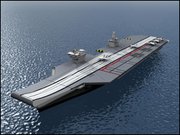Future French aircraft carrier
|
|
A new generation of aircraft carrier developed both for the French Marine nationale based on the Thales design for a UK future aircraft carrier, CV(F). The vessel will displace approximately 50,000 tonnes—almost three times the displacement of the current British Invincible-class carriers. The carrier will be based in Toulon, Var, France. The requirement for the carriers was confirmed by Jacques Chirac in 2004 for the centennial of the Entente Cordiale.
An alliance of Thales and DCN will develop and build the aircraft carriers from the French Thales design. While the UK in-service dates of 2012 and 2015 for their two carriers have been announced, the construction timetable for the French ship has not been disclosed although 2015 is rumored.
The French and British vessels will be the largest and most powerful surface warships outside of the US Navy. They are designed to operate the Lockheed Martin F-35 (JSF) and the Dassault Rafale for standard version and the F-35B STOVL variant the initial UK version of the carrier. The vessels are expected to be capable of carrying 48 F-35s or a similar quantity of Dassault Rafales, four airborne-early-warning (AEW) aircraft and six support/anti-submarine helicopters, for example the AgustaWestland EH101. The crew will be about 600, only 15 more than the Invincible, indicating the high level of automation being integrated into the ships' systems.
The French decision comes as a result of the centennial of entente cordiale. To proceed to the construction of the aircraft carrier however has aroused numerous controversies in France where the idea to renounce nuclear propulsion in order to favour British needs is seen as a backward step for the French technology. However, the numerous problems with the propulsion system of the FS Charles de Gaulle and the fact that the design was tailored to the Royal Navy's requirements leaves little choice.
The Ministry of Defense decided not to use nuclear propulsion for the aircraft carrier because of high costs. The carrier's propulsion system will be Integrated Full Electric Propulsion (IFEP) based on four gas turbines. It is expected that the Royal Navy will continue its investment in the WR-21 advanced cycle gas turbine engines for the carrier. The optimum location for the position of the main propulsion system is being examined, with maximising the hangar space below decks a major consideration. The range of the carrier will be 10,000 nautical miles (19,000 km).
The construction of the hull will involve a series of superblocks that will be joined to form the ensemble of the structure, so as to obtain a drastic cost reduction of production.
Missing image
Cvf-bae-blocks.jpg
Thales Block Design
UK Variant
55,000 tonnes (proposed originally), 60-65,000 tonnes (current proposals) displacement
The large size of the carrier is a major issue. With the proposed specification of at least 55,000 tonnes displacement and a length of 274 m (900 ft), it will be difficult for them to routinely and safely enter and berth at either of the RN's main two naval bases, Portsmouth Naval Base and Devonport Naval Base. Moreover, there is no suitable dry dock for a CVF at either base, the No.10 Dock at Devonport being restricted to ships of about 40,000 tonnes and 259 m (850 ft) length, while the biggest two docks at Portsmouth are slightly smaller (259 m long with a 33 m beam, 256 m long respectively). Lengthening of any of these docks, or the construction of a new dry dock, would be a major and expensive exercise.
However, the Ministry of Defence does not seem to regard this as an issue that will determine the size of the new carriers. Disputes over their size have been due to the cost of building not maintaining them.
French Variant
Thales Naval France and DCN have proposed a 275 m long, 58,000 tonnes variant of the CVF for the French Navy's second aircraft carrier (PA2). They intend that the hull will be built by Chantiers de l'Atlantique at Saint Nazaire, and fitting out will be by DCN at Brest. Chantiers de l'Atlantique are able to build larger ships than a CVF (in 2003 they built the 345 m RMS Queen Mary 2), thus whole-ship rather than superblock construction techniques can be adopted, this also means that the French could adopt a more complex and hydrodynamically-efficient hull, which would be too risky for the UK. Moreover the French are not confined by the physical restrictions of the Rosyth No.1 dock, as the British are. For example, the French aircraft carrier may also have a beam wider than the maximum permitted to UK ships. The French Marine Nationale will base its new carrier at the Toulon naval base. Two huge dry docks avilable there are able to accommodate even a Nimitz-class aircraft carrier.
France expects to order at the end of 2006, and the objective of having the new carrier operational before the beginning of the refit and refuelling scheduled for the nuclear carrier Charles de Gaulle in 2015.

